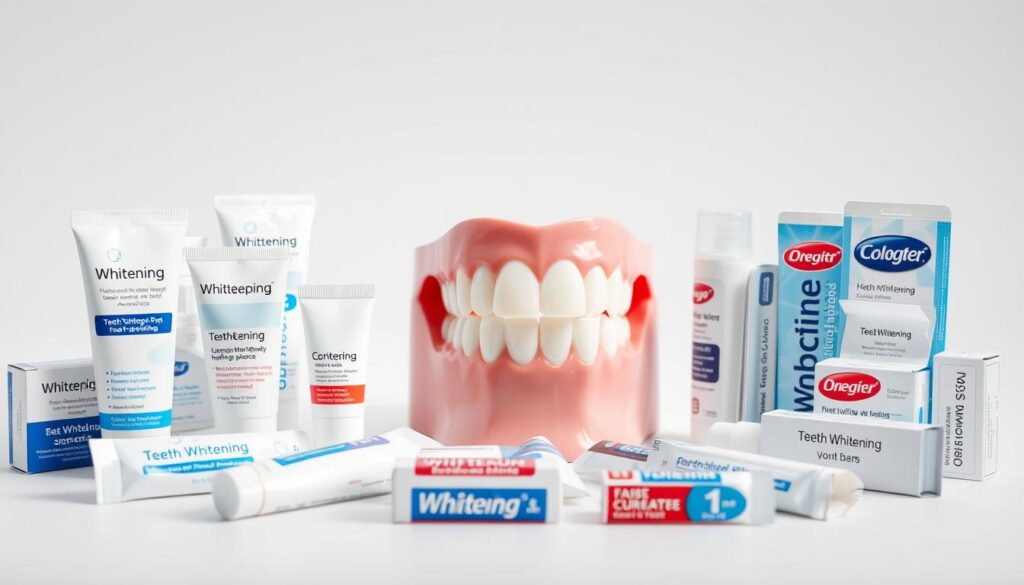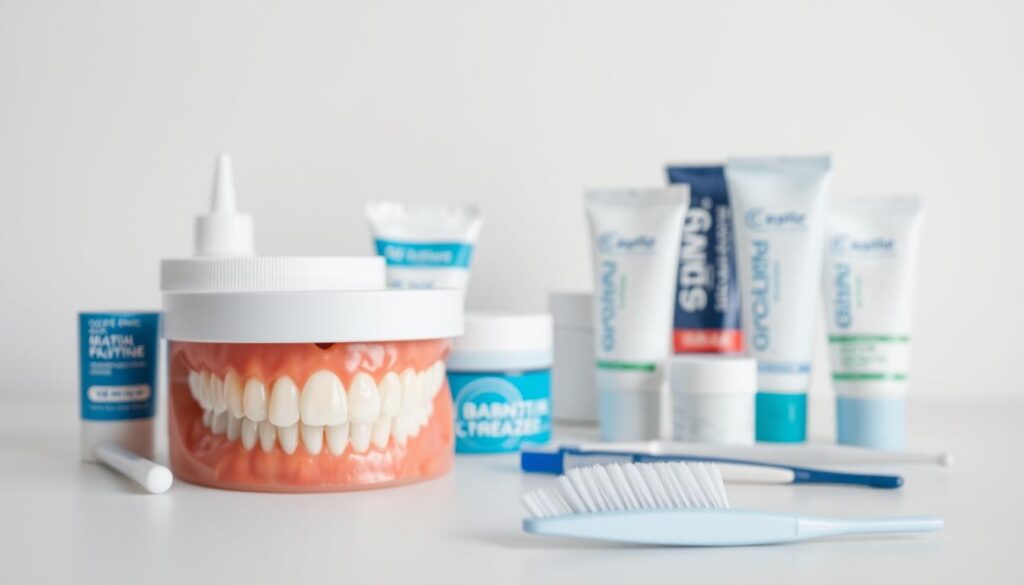Why do professional treatments outperform store-bought whitening strips for lasting results?
Many people dream of a brighter smile but face challenges with ineffective or unsafe methods. To achieve a whiter smile, it’s important to know which options are safe and effective. Over 80% of Americans are unhappy with their tooth color, yet only 30% use ADA-approved safe teeth whitening options.
This guide will debunk myths and share evidence-based strategies. You’ll learn about clinical procedures and everyday habits that work. Discover how professional methods like dentist-administered treatments can give faster results than over-the-counter products.
Natural remedies like crunchy vegetables and oil pulling are also effective and affordable. Find out which ADA-approved products safely reduce stains. Learn how making lifestyle changes can help keep your smile bright.
Key Takeaways
- Professional treatments use stronger bleaching agents than home products.
- ADA Seal of Acceptance ensures safety and efficacy in whitening products.
- Natural options like apples and carrots aid in stain removal and saliva production.
- Hydrogen peroxide and baking soda are common active ingredients in safe methods.
- Combining clinical care with daily habits maximizes long-term results.
Understanding the Science Behind Teeth Staining
Teeth staining comes from both our habits and our body’s processes. Knowing this helps us pick the right teeth whitening methods and best teeth whitening products for us.
Extrinsic vs. Intrinsic Tooth Discoloration
Stains fall into two groups based on where they come from:
| Type | Cause | Location | Treatment Options |
|---|---|---|---|
| Extrinsic | External factors (chromogens in food/drink) | Surface enamel | Professional cleanings, best teeth whitening products |
| Intrinsic | Internal factors (aging, medications, trauma) | Tooth structure | In-office teeth whitening methods like professional bleaching |
Common Causes of Yellow and Stained Teeth
Some main causes are:
- Darkly pigmented foods/drinks (coffee, tea, berries)
- Tobacco use (tar and nicotine)
- Medications like tetracycline
- Poor oral hygiene enabling chromogen buildup
How Age Affects Tooth Color
As we age, our enamel wears down. This exposes the yellowish dentin layer, making teeth look darker. Professional treatments are often needed to tackle deep stains from aging. The effects of teeth whitening methods lessen as enamel wears off, so we need more frequent touch-ups.
Knowing these factors helps us make better choices about treatments. Age-related changes often need professional help for the best results.
Professional Teeth Whitening Methods at the Dentist
Professional teeth whitening offers advanced ways to brighten your smile. Dentists use their skills to ensure treatments are safe and effective. These teeth bleaching treatments use stronger agents than what you can buy at home, tailored to your needs.

In-Office Bleaching Treatments
Dentists apply hydrogen peroxide solutions (15-38% concentration) directly to your teeth during in-office sessions. They protect your gums and soft tissues. A single visit can significantly reduce surface stains, and you’ll see results right away.
The Zoom! system, for example, combines gel and light to lighten teeth up to eight shades in 60 minutes.
Laser Whitening Procedures
Laser whitening uses light energy to speed up the bleaching process. Systems like Zoom! use LED or laser technology to activate hydrogen peroxide. Benefits include:
- Reduced treatment time compared to at-home methods
- Customized light wavelengths to enhance gel penetration
- Immediate visual improvement
Custom-Fitted Whitening Trays
Custom trays are made to fit your mouth perfectly. You apply professional-grade gel (10-15% carbamide peroxide) at home for 2-4 weeks. This method offers controlled bleaching with gradual results, avoiding sensitivity risks.
Expected Results and Duration
Professional methods can last 1-3 years, depending on your oral habits. Smoking or frequent coffee consumption may reduce longevity. For severe discoloration, porcelain veneers or crowns provide durable solutions, maintaining brightness for up to 15 years with proper care.
Popular At-Home Teeth Whitening Products
At-home teeth whitening makes it easy to keep your smile bright. The best teeth whitening products are safe and work well. They often have ingredients like carbamide peroxide, approved by the ADA. You can find strips, gels, and pens for daily or occasional use.
- Crest 3D White Whitestrips Professional Effects: $44.99 (Target) gives you 6 shades brighter in 20 minutes. It has 10% hydrogen peroxide to remove stains.
- Plus White 5 Minute Kit: $11.49 (Rite Aid) has a gel with 12% carbamide peroxide for fast whitening. It’s good for sensitive teeth.
- Dr. Collins All White 22% System: $20.49 (Target) comes with a 22% carbamide peroxide gel and trays. It lasts for 14 days.
- Walgreens Extreme Whitening Wraps: $14.99 (Walgreens) has a 15% carbamide peroxide gel in strips. It’s for smaller mouths and is easy to use.
- Hager Pharma Mirawhite Oxygen Pen: $31.99 (CVS) has a 6% hydrogen peroxide gel in a pen. It’s easy to use and whitens discreetly.
Top best teeth whitening products come with UVC cases or LED lights for easy use. Wireless LED devices, like the CVS Platinum Kit, help the ingredients work better. Always look for ADA approval and follow the instructions to protect your teeth.
Professional formulas, like those with 35% carbamide peroxide, might need a dentist’s advice. For sensitive teeth, choose gentler options or formulas made for sensitivity. Using ADA-approved products and good oral care can keep your teeth white without harm.
What is the Best Way to Whiten Your Teeth?
Choosing the right teeth whitening method depends on your needs and goals. Effective teeth whitening techniques differ based on the type of stain and your preferences. Professional teeth whitening methods like laser treatments work fast but can be pricey.
At-home whitening is convenient, but natural remedies can be risky if not used correctly.

| Method | Effectiveness | Cost Range | Best For |
|---|---|---|---|
| Professional Laser Whitening | Fast, up to 10 shades lighter | $500–$1,000 | Severe stains, quick results |
| At-Home Trays | Moderate improvement | $50–$200 | Maintaining results, mild stains |
| Natural Remedies | Risk of enamel damage | Low cost | Risk-aware individuals only |
Comparing Effectiveness Across Methods
Studies show in-office laser treatments, like those at Aspen Dental, can whiten teeth in under an hour. These treatments use 6% hydrogen peroxide, much stronger than what you can buy over the counter. Over-the-counter products may take weeks to show results.
Cost vs. Results Analysis
- Laser whitening costs $500–$1,000 but lasts 6–24 months
- At-home kits cost $50–$200 with 1–2 shade improvements per month
- Natural methods (e.g., activated charcoal) lack FDA approval and may harm enamel
Personalized Approaches Based on Stain Type
Stains from coffee or tobacco work well with professional polishing and at-home trays. But, stains from medication or aging might need in-office treatments. For example, tetracycline stains often need multiple sessions.
People with dental work should talk to a dentist first. Whitening doesn’t change the color of crowns or fillings.
Natural Teeth Whitening Remedies That Actually Work
Natural teeth whitening remedies are safe and affordable. They help keep your smile bright without harsh chemicals. These methods use everyday items that are backed by science.
Oil Pulling and Its Benefits
Oil pulling with coconut oil involves swishing the oil for 15–20 minutes. It may reduce bacteria that cause stains. Studies show it can improve oral health and whiten teeth slightly. Use it in small amounts to avoid harming your teeth.
Activated Charcoal: Fact vs. Fiction
Activated charcoal can pull stains from your teeth. But, its rough texture can wear away your enamel. Dentists say to use it carefully and only when needed.
Fruit Enzymes and Baking Soda Applications
Fruits like strawberries and pineapple have malic acid and enzymes. They help break down stains. Mix baking soda with water to make a paste. Use it no more than twice a week to protect your enamel.
| Food | Benefits | Key Nutrients |
|---|---|---|
| Apples | Crunchy texture exfoliates teeth | Malic acid, vitamin C |
| Carrots | Stimulates saliva production | Vitamin A, fiber |
| Broccoli | Natural scrub for plaque removal | Iron, calcium |
| Cheese | Lactic acid strengthens enamel | Cacium, casein |
Eat these foods regularly and brush your teeth often. Also, get professional cleanings for the best results. Always talk to a dentist before starting new routines to keep your teeth safe.
Safety Considerations for Teeth Whitening
Before you try safe teeth whitening options, talk to a dentist first. Whitening treatments can make your teeth sensitive or irritate your gums, if done too much. A dentist can give you advice that fits your mouth’s health.

- Follow product instructions precisely to avoid enamel damage.
- Avoid at-home methods using household items like baking soda or apple cider vinegar, which may erode tooth surfaces.
- Never use store-bought hydrogen peroxide for whitening without professional oversight.
- Individuals with restorations like crowns should discuss compatibility with their dentist first.
Feeling cold sensitivity is normal but usually goes away in 48 hours. If the pain lasts, it might mean you’re using too much or have a problem that needs a dentist’s check. Pregnant women and those under 16 should not use most whitening treatments without a dentist’s okay.
Lab studies show excessive bleaching can alter tooth microstructure, though real-world effects depend on proper application.
Use only teeth bleaching treatments your dentist recommends for safety. Regular dental visits are key to keeping your teeth and gums healthy. Brushing well and avoiding foods that stain your teeth will help keep your smile bright without harming your teeth.
Preventing Future Stains: Dietary Habits and Lifestyle Changes
To keep teeth white, you need to take care of them every day. Changing what you eat and how you live can help. Here are some tips to stop stains from forming:
Foods and Beverages That Stain Teeth
| Substance | Stain Cause | Mitigation Strategy |
|---|---|---|
| Coffee/Tea | Chromogens and tannins bind to enamel | Use straws; rinse immediately |
| Berries/Wine | Anthocyanin pigments | Eat cheese afterward to neutralize acids |
| Soda | Acids erode enamel, enabling stains | Drink through a straw; rinse with water |
Smoking Cessation for Whiter Teeth
Smoking stains teeth because of the chemicals in tobacco. Quitting smoking helps your teeth stay whiter. The American Lung Association says smokers can get back to 90% of their lung function in 5 years. Teeth stains also fade in 12–24 months after quitting.
Daily Habits That Preserve Whiteness
- Brush twice daily with ADA-approved fluoride toothpaste
- Floss daily to remove interdental staining particles
- Drink water after consuming staining substances
- Incorporate fibrous foods like apples and celery to naturally scrub teeth
Eating foods that stain teeth with dairy products like yogurt or cheese helps. Regular dental cleanings every six months remove stains. Keeping up with good oral hygiene is key to keeping teeth white.
How to Maintain Your Newly Whitened Smile
Keeping your smile bright after professional whitening needs careful care. Talk to your dentist to make a plan that fits you. This plan should include regular touch-ups and daily habits to keep your teeth white and healthy.

Recommended Follow-Up Treatments
Getting touch-ups is important for keeping your smile bright. You should get in-office or at-home teeth whitening methods every 6–24 months. Also, don’t forget to get your teeth cleaned twice a year to remove stains and plaque.
Right after your treatment, avoid eating or drinking dark foods and drinks for 48 hours. This helps prevent your teeth from getting stained again.
Products That Extend Whitening Results
Use gentle best teeth whitening products every day. Whitening toothpaste is good for polishing your teeth without harming them. Your dentist can also give you custom trays for bleaching your teeth safely.
Follow the instructions on these products to avoid using too much whitening agent. This helps keep your teeth healthy and white.
| Maintenance Step | Recommended Frequency |
|---|---|
| Professional cleanings | Every 6 months |
| Touch-up treatments | Every 12–24 months |
| Whitening toothpaste | 2–3 times weekly |
Stay away from harsh products that can damage your enamel. Regular flossing and drinking water also help prevent plaque. By following these steps, your smile will stay bright between professional treatments.
Special Considerations for Sensitive Teeth and Dental Work
People with sensitive teeth or dental work need special care for whitening. Dentists say to choose safe teeth whitening options that don’t hurt but work well.
Whitening Options for Sensitive Teeth
For sensitive teeth, use low-strength peroxide or products like Lumineux strips that don’t have peroxide. Look for products with potassium nitrate to block pain and fluoride to make enamel stronger. Crest Whitening Emulsions mix hydration with whitening to calm teeth. Stay away from harsh ingredients like charcoal or baking soda, as they can make sensitivity worse.
Dental Work and Whitening Compatibility
Crowns, veneers, and fillings don’t change with whitening. But, natural teeth around them can get lighter, causing color differences. Before starting, dentists might suggest:
- Whitening natural teeth first to see the shade before doing new restorations
- Replacing old fillings to stop decay and color issues
- Not whitening near composite fillings to avoid bond weakening
After whitening, some might need to adjust their restorations to match the new tooth color.
Professional teeth whitening is key for those with dental work. Dentists can make plans using desensitizing gels or night guards to protect dental work. Always fix sensitivity problems like cavities or gum recession before whitening to get the best results.
Conclusion: Creating Your Personal Teeth Whitening Plan
Your journey to a brighter smile starts with a plan made just for you. First, visit a dentist like Dr. Dhiren Ahir at Prime Dentistry. They will check your enamel health and find out why your teeth are stained. This ensures you get safe and effective treatments.
For quick results, try in-office whitening. It uses strong bleaching agents to remove stains fast. You can also use custom trays like Opalescence Go. They whiten your teeth with fluoride and help prevent sensitivity.
At-home whitening is easy and convenient. Whitening strips cost between $25 and $65 and can last up to four months. But, you need to use them every day. You can also try natural methods like oil pulling or baking soda, but do it carefully to avoid damaging your enamel.
Always follow the instructions on whitening products to avoid sensitivity. If you feel any discomfort, use desensitizing toothpaste.
Maintaining your smile is important. Brush your teeth twice a day with whitening toothpaste. Use a straw when drinking dark beverages and get your teeth cleaned every six months. Don’t overdo it with whitening products—use them no more than four times a year to protect your enamel.
Fix any cavities or gum problems before starting any whitening treatment. A plan that fits your needs, budget, and dental history is best. Prime Dentistry offers custom solutions that are safe and effective. By following a consistent routine and getting professional advice, you can keep your smile bright and healthy.
FAQ
What are the most effective teeth whitening methods?
Are professional teeth whitening treatments safe?
Can I achieve results with at-home teeth whitening products?
What natural teeth whitening remedies are considered effective?
How can I prevent future teeth staining?
What should I know about teeth whitening if I have sensitive teeth?
How long do the results of teeth whitening last?
Are there risks involved in teeth whitening?
What are the costs associated with professional teeth whitening?
What are the most effective teeth whitening methods?
Are professional teeth whitening treatments safe?
Can I achieve results with at-home teeth whitening products?
What natural teeth whitening remedies are considered effective?
How can I prevent future teeth staining?
What should I know about teeth whitening if I have sensitive teeth?
How long do the results of teeth whitening last?
Are there risks involved in teeth whitening?
What are the costs associated with professional teeth whitening?
FAQ
What are the most effective teeth whitening methods?
Professional treatments like in-office bleaching and custom trays are top choices. At-home options like strips and toothpaste also work well. The best method depends on your teeth’s color and health.
Are professional teeth whitening treatments safe?
Yes, professional treatments are safe when done by a dentist. They use strong whitening agents safely. Always talk to your dentist about any health concerns first.
Can I achieve results with at-home teeth whitening products?
Yes, at-home products can give good results if used regularly. Strips, LED kits, and toothpastes are popular. But, they might take longer than professional treatments.
What natural teeth whitening remedies are considered effective?
Natural remedies like oil pulling and baking soda can work. Fruits with enzymes also help. But, they’re not as strong as commercial products. Use them carefully to avoid harm.
How can I prevent future teeth staining?
To avoid stains, eat less staining foods and drinks. Quit smoking and brush well. Regular dental cleanings also help.
What should I know about teeth whitening if I have sensitive teeth?
Sensitive teeth can use special whitening products with potassium nitrate. Talk to your dentist to find the right product for you.
How long do the results of teeth whitening last?
Whitening results last 1 to 3 years, depending on your habits and health. Regular treatments can keep your teeth white longer.
Are there risks involved in teeth whitening?
Whitening is mostly safe, but it can cause sensitivity and gum irritation. Be careful not to damage your teeth with too much use. Always follow your dentist’s advice.
What are the costs associated with professional teeth whitening?
Professional whitening costs 0 to
FAQ
What are the most effective teeth whitening methods?
Professional treatments like in-office bleaching and custom trays are top choices. At-home options like strips and toothpaste also work well. The best method depends on your teeth’s color and health.
Are professional teeth whitening treatments safe?
Yes, professional treatments are safe when done by a dentist. They use strong whitening agents safely. Always talk to your dentist about any health concerns first.
Can I achieve results with at-home teeth whitening products?
Yes, at-home products can give good results if used regularly. Strips, LED kits, and toothpastes are popular. But, they might take longer than professional treatments.
What natural teeth whitening remedies are considered effective?
Natural remedies like oil pulling and baking soda can work. Fruits with enzymes also help. But, they’re not as strong as commercial products. Use them carefully to avoid harm.
How can I prevent future teeth staining?
To avoid stains, eat less staining foods and drinks. Quit smoking and brush well. Regular dental cleanings also help.
What should I know about teeth whitening if I have sensitive teeth?
Sensitive teeth can use special whitening products with potassium nitrate. Talk to your dentist to find the right product for you.
How long do the results of teeth whitening last?
Whitening results last 1 to 3 years, depending on your habits and health. Regular treatments can keep your teeth white longer.
Are there risks involved in teeth whitening?
Whitening is mostly safe, but it can cause sensitivity and gum irritation. Be careful not to damage your teeth with too much use. Always follow your dentist’s advice.
What are the costs associated with professional teeth whitening?
Professional whitening costs $300 to $1,000, based on the treatment and location. Talk to your dentist about costs and insurance before starting.
,000, based on the treatment and location. Talk to your dentist about costs and insurance before starting.





